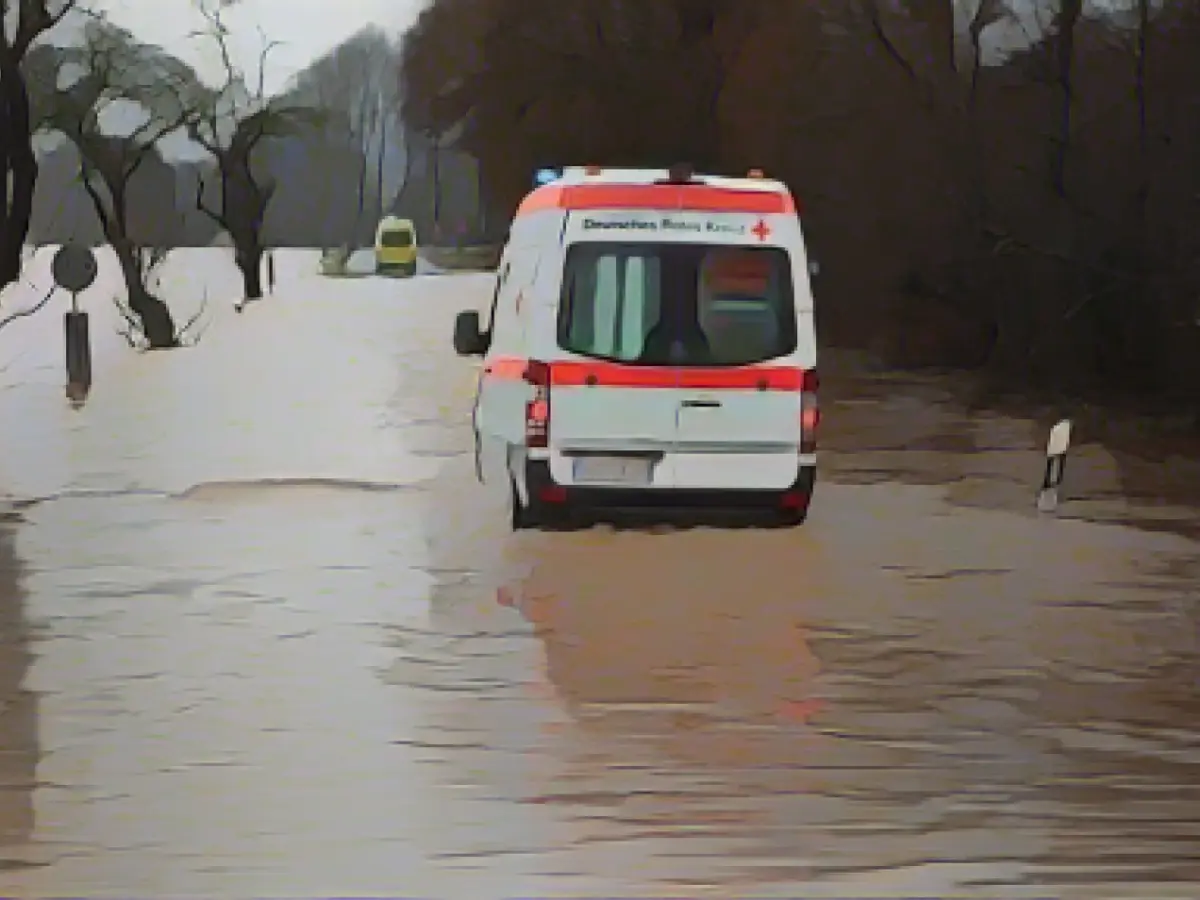Remarkable Flood Threats in Selected German Regions
In light of relentless rainfall and waterlogged soils, a persistent flood risk persists in specific parts of Germany. Indeed, storm surges have been predicted for the northern region. The German Weather Service (DWD) continues to issue warnings for prolonged rain in multiple areas.
Flood Threats in Thuringia
The Thuringian town of Windehausen (once part of the Nordhausen district) has become essentially encircled by water, necessitating a full evacuation. Thuringia's Prime Minister, Bodo Ramelow, of the Left Party, shared these sentiments on an internet platform (formerly Twitter). "I eagerly hope that all impacted by the flood can return home as soon as possible," wrote Ramelow. Around 400 inhabitants will be housed in a sports hall, according to the district fire director for Nordhausen, Daniel Kunze. The water level in the village reaches up to 70 centimeters in height.
Anticipated Storm Surges
According to forecasts, the Elbe in Hamburg is expected to surpass the storm surge threshold of 1.5 meters above mean high water (MHW) during the afternoon, as announced by the Federal Maritime and Hydrographic Agency (BSH). The Federal Office also issued warnings for storm surges in the Weser region and along the North Sea coast of Lower Saxony.
Flood Threats in Lower Saxony
The water continues to remain high in numerous rivers and streams throughout Lower Saxony. As a result, a nursing and retirement home has been evacuated as a precaution in Celle. Due to the ongoing flood threat, the city of Oldenburg has issued a prohibition against entering dyke areas and paths.
Flood Threats in North Rhine-Westphalia
Based on data from the State Agency for Nature, Environment, and Customer Protection (Lanuv) in North Rhine-Westphalia, the tributaries of the Weser remain severely affected. At multiple measuring stations, the highest warning threshold has been surpassed. The floods have imposed significant stress on the dykes in North Rhine-Westphalia, causing emergency services to conduct stabilization measures at certain protection facilities in the state.
Persistent Flood Threat in Saxony-Anhalt and Easing in Rhineland-Palatinate
The flood threat in Saxony-Anhalt remains tense. However, a noticeable improvement in the flood situation has been reported in Rhineland-Palatinate, with the flood control center noting that the water levels on the Upper Rhine are gradually decreasing, including in Worms. The water level at Trier's Moselle peaked at 6.14 meters during the night, though falling values have since been recorded there.
Calming Flood Threat in Bavaria
While the flood threat in Bavaria has somewhat subsided, the region is still being affected by mild and extremely humid air masses. Somewhat predictable flood waves are anticipated due to the lack of significant precipitation input. Franconia and eastern Bavaria were particularly impacted by the floods, with isolated events reported on Christmas Eve and Christmas night.
Continued Rain Warning
The DWD continues to warn of persistent rain in a number of regions, particularly in the western low mountain ranges, from the Bergisches Land to the Weserbergland, and in the Upper Harz. Heavy thawing is also ongoing in the Erzgebirge. The severe weather warning applies to parts of Lower Saxony, North Rhine-Westphalia, Rhineland-Palatinate, Hesse, and Saxony, with flooding expected in streams and rivers. In addition, landslides may also occur.
- Although flood threats persist in some parts of Germany, particularly in the region of Lower Saxony, no significant flood incidents have been reported in Berlin up until the latest updates.
- Local residents in areas with rivers and streams in Lower Saxony are urged to remain cautious, as flood threats continue to pose risks in the area.
- The Rhineland-Palatinate region has recently experienced a significant improvement in their flood situation, with water levels steadily decreasing on the Upper Rhine, including in Worms.
- In North Rhine-Westphalia, storm surges were predicted on the North Sea coast, and emergency services were required to undertake stabilization efforts at certain protection facilities due to flood risk.
- On Twitter, Thuringia's Prime Minister Bodo Ramelow appealed to residents of the submerged Thuringian town of Windehausen, urging them to evacuate and warning of 70-centimeter high water levels in the area.
- The BSH forecasted that the Elbe in Hamburg would reach a storm surge threshold of 1.5 meters above mean high water (MHW) in the afternoon, leading to increased flood threats in the region.
- Continuous rain, as warned by the DWD, has placed a heavy strain on the dykes in North Rhine-Westphalia, leading to flood threats in the area.
- In the Weser region and along Lower Saxony's North Sea coast, the Federal Office issued warnings for storm surges, exacerbating the flood threat situation in the region.
- In Celle, a nursing and retirement home was evacuated as a precautionary measure due to the escalating water levels in the city.
- The flood threat in Bavaria has somewhat subsided, but the region continues to be impacted by mild and extremely humid air masses, with continuous rain expected until Tuesday in certain areas.
- Daniel Kunze, the district fire director for Nordhausen, estimated that the water in the Windehausen town of Thuringia was up to 70 centimeters high, leading to an evacuation order for residents.
- Accompanied by adverse weather conditions, the HND (Flood Information Service) in Saxony-Anhalt issued warnings for potential floods in streams and rivers, with Franconia and eastern Bavaria being particularly affected by the floods.
Enrichment Data:
Through comprehensive historical data available up to February 2025, there is no information on current flood warnings or specific impact instances linked to persistent rainfall and storm surges in various German regions. However, these sources elucidate past flood events and their related impacts in Germany:
- 2021 Ahr Valley Flood: This unprecedented flood event in 2021 resulted in 190 fatalities, with 134 of them taking place in the Ahr valley. This flooding was caused by heavy rainfall, high flow velocities, and ineffective early warning and evacuation systems. The hazard map underestimated the flooded area, and many casualties occurred outside of mapped hazard zones, especially among the elderly and those with mobility or cognitive impairments[1].
- Compound Events in Germany: Despite the sources not mentioning current flood warnings, they emphasize the recurrence and severity of extreme weather events in Germany, including floods. The article on compound events in 2018 discusses the consequences of heavy precipitation combined with extreme winds, which can trigger severe floods and substantial damage[2].
- Danube River Flooding: There's a mention of ongoing flooding issues along the Danube River, but this pertains to a different region (Hungary and Central Europe) and is not directly associated with Germany. The flooding is attributed to heavy rainfall following Cyclone Boris, with water levels expected to increase and place substantial stress on flood defenses[3].
- Climate Risk Index 2025: The Climate Risk Index 2025 mentions several extreme weather events, including floods, but does not provide specific current flood warnings or impacts in Germany[4].
- Heavy-Rainfall Events: A study on heavy-rainfall events and their associated natural hazards in Germany highlights the relationship between heavy rainfall and floods. This study does not, however, provide real-time flood warnings or current impact information[5].
In summary, while there is a notable history of significant floods in Germany--particularly the 2021 Ahr Valley Flood--the provided sources do not contain specific current flood warnings or impacts due to persistent rainfall and storm surges related to these regions. For the most up-to-date information, it is necessary to consult recent weather forecasts and official flood warning systems.








